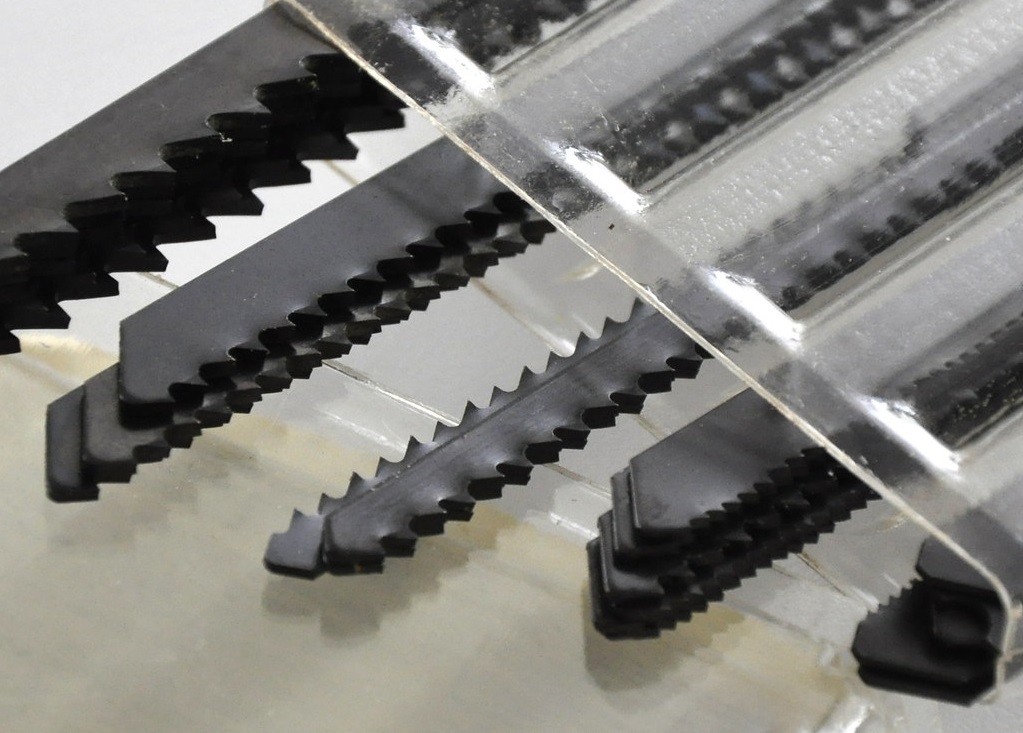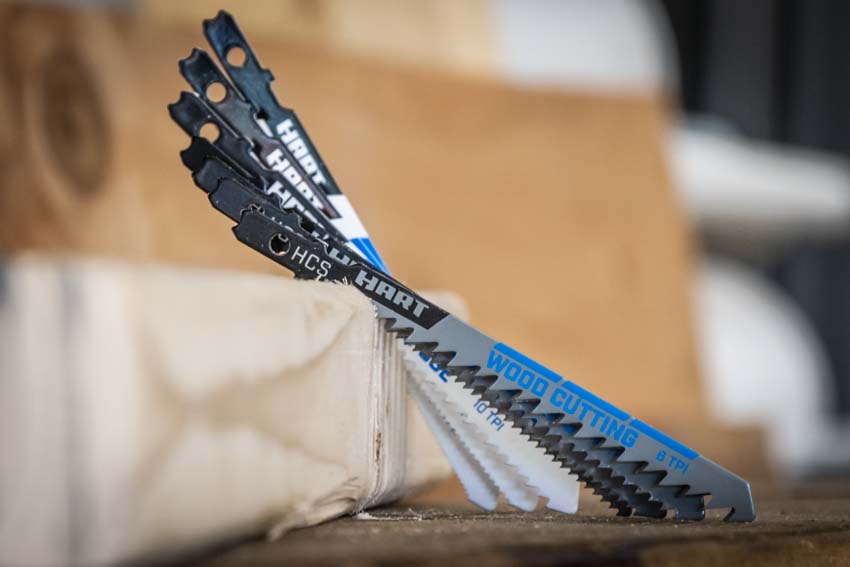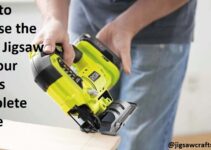Struggling to choose a jigsaw blade for your woodworking project? Don’t worry, you’re not alone!
In this guide, you’ll learn everything you need to know about choosing the right jigsaw blade for any job. With this helpful information, you’ll be able to make perfect cuts and complete your project quickly and easily.
When you want to cut through materials with precision, the right jigsaw blade for the job is essential. Choosing the right jigsaw blade can be daunting given the range of types, sizes and applications.
In this guide, we will provide all the information you need to select a blade that will give perfect results on any project. We will also show how to select and use blades for different materials such as wood, plastics and metals, so you get smooth professional results in no time.
Explanation of the importance of choosing the right jigsaw blade
Any jigsaw project will be less successful if you do not choose the correct saw blade for it. The wrong blade can make your job more difficult, prevent intricate work from being achieved, and even cause the tool to break in some cases. To find the best saw blade for your jigsaw project, select according to material type and fineness of curve.
When cutting material such as metal, it is important to ensure that the teeth on your saw blade are very sharp for a smooth cut. For tougher materials such as hardwoods and composites, a thicker gauge with larger teeth is recommended so that the blade can handle the pressure without breaking or bending. More fragile materials like clay or cardboard may require a finer-toothed blade so as not to tear apart or rip up material.
When it comes to curves and patterns, knowing when to use which types of blades will help you complete a successful project faster and with more perfectionism. Before selecting a saw blade for curves and patterns, consider how fine or delicate you need your cut lines to be. If you want extra fine cuts, then consider using narrow blades with tiny teeth – these will give infinitely finer details than thicker-toothed blades; however they will require extra caution due to their brittleness when working with tougher materials or when making curved lines quickly. For larger curves, heavier-gauge blades are recommended because they can resist bending in tighter turns while still allowing sharper edges in tighter corners if necessary.
By understanding what type of material you are cutting and how delicate or intricate the shapes you need to cut out may be, you can easily choose the right saw blade for your jigsaw project every time – giving yourself better results in shorter amounts of time!

Understanding Blade Teeth
Choosing the right jigsaw blade for your project also requires understanding some of the characteristics of the blades. Blade teeth are designed to cut in a particular way so whenever selecting a blade, take a close look at the number and pattern of the teeth.
Generally, blades come with two types of teeth: U-shaped and T-shaped. Blades with U-shaped or V-shaped teeth tend to work better for straight cuts while those with T-shaped teeth are better suited for curved cuts. Additionally, there is variation within both types in terms of how they cut. The material that you are working with should also be taken into account when deciding on the number and configuration of your blade’s teeth – softer materials require less aggressive blades while harder materials require greater penetration and a finer tooth count.
You will want to look at how thick, long and sharp each tooth is as well as how far apart they are on the blade – these measurements will influence your cut quality (with respect to speed, cleanliness, etc.). Coarser blades offer quicker cutting but leaves edges that require more sanding; whereas finer blades provide slower cutting speeds but leave cleaner edges that require little sanding. Be sure to experiment beforehand so you know what works best for your particular project material and desired finish results prior to committing to any type of blade setup.
Explanation of the significance of blade teeth in choosing a jigsaw blade
The number and size of the teeth on a jigsaw blade are key factors in ensuring that your cut is successful. Blade teeth come in several sizes and styles, so it’s important to know when to use each type. The biggest difference between blade types is the number and size of the teeth. Blade tooth size can range from extra-large for very thick materials, to extra-small for extremely thin materials.
It is also important to make sure that you choose the right style of blade for your project; whether it’s a standard (or straight) tooth, a skip tooth, or a combination style blade.
Standard blades are great for general use on most materials. They feature large teeth that are designed to be strong and effective when cutting through larger pieces of material. Skip tooth blades are designed with alternating high and low heights (like ‘ok’ signs) that provide less resistance as they travel through the material being cut; this makes them useful when cutting very small pieces of material or making tight curved cuts.
Finally, combination styles have both large and small teeth which can provide superior strength compared to individual straight or skip tooth blades alone; they are especially useful in situations where precision cutting is needed along with tough materials like plastic or hardwood.

Discussion of the different tooth configurations and their uses
There is an array of different jigsaw blades available in terms of tooth configuration. Generally, the number of teeth per inch on a jigsaw blade can range from 10 to 32. The lower the number, the coarser the blade which makes it good for cutting thick materials like metal and hardwood. Higher numbers of TPI are ideal for more general use, with finer cuts due to its smaller teeth creating a smoother finish. Generally speaking, blades with fewer than 14 TPI deliver faster but rougher cuts where as those with up to 18 TPI can provide good overall results but take longer to complete a job.
The shape and angle of the teeth is another factor that affects a blade’s performance. Standard tooth configurations are typically ‘U-shank’ and ‘T-shank’ for slightly different needs. U-shank blades have wider gaps between the teeth that help them resist clogging when cutting thicker or softer materials like wood or plastic, while T-shank blades are suited to thinner and harder materials such as metal or ceramic tiles. One small but important distinction between these two types of blades is that U-shank blades do not usually allow bevel cuts whereas T-shank blades often do – more on this later!
In addition to U and T shanks, there are other options available including HSS (High Speed Steel), variable pitch and combination sets that offer different sizes with one handle. HSS jigsaw blades offer strength and durability while variable pitch cuts require less power thanks to their widely spaced teeth which prevent clogging when cutting denser material like particle board – great for complex curves! Finally combination sets consist of several individual pieces per pack making them perfect for all types of tasks from large scale sawing down through finer finish work such as prepping new home décor items or furniture refurbishment projects!
Blade Material
Not all jigsaw blades are made of the same material. Different types of blades are used to cut different types of materials. The best way to ensure that you get the right blades for your project is to understand each blade type and its application.
Carbon Steel Blades- These are some of the most common blades and are great for cutting both hard and soft woods, as well as plastic, laminate, and composite materials. They have teeth that are medium in size and usually feature a set pattern (alternating teeth).
High Speed Steel (HSS) Blades- High speed steel is a very strong alloy that can easily cut through hard woods, thin metals, plastics, composites and more. HSS blades stay sharper longer than carbon steel but they cannot be resharpened when they become dull.
Bi-Metal Blades- Bi-metal blades have teeth made from two different metals that help them last longer than standard steel blades when used on tough materials like stainless steel or composites. They are not as sharp or durable as HSS blades but they offer an excellent value for the price.
Tungsten Carbide Tipped Blades – These specialized blades use tungsten carbide tips instead of traditional metal teeth to provide superior cut quality on extremely tough materials like ceramic tile, brass, stainless steel and concrete block. While they can be used on softer materials like wood or plastic, they tend to wear out much more quickly when compared with other types of jigsaw blade materials.
Overview of the different materials used to make jigsaw blades
Using the wrong blade for a project can lead to unsatisfactory results, so it’s important to choose a blade that is suitable for the task at hand. Jigsaw blades come in various shapes, sizes, and materials that are designed to cut through different types of materials. To help you make the right choice, here is an overview of the different materials used to make jigsaw blades:
High-Carbon Steel – This type of material is often used when cutting soft woods such as pine or plywood. The high levels of strength provided by carbon steel make it especially suitable for larger and thicker tasks; however, it can wear down quicker than some other varieties.
High-Speed Steel – A stronger alternative to carbon steel, high-speed steel provides superior performance as it is resistant to heat and abrasion. It can be used for precise cuts with fewer vibrations on harder woods and fiberboard.
Tungsten Carbide Tips – This material offers optimal performance when cutting hardwoods like oak or mahogany, metal alloys and even ceramic tiles. The tungsten carbide tips provide increased durability along with enhanced cutting power enabling you to tackle more demanding projects while protecting the surface of your workpiece.
Carbide Grit – Designed specifically for use with wood and masonry materials, this blade has diamond chips that have been embedded into its body which facilitate efficient cutting action while ensuring minimal chipping or kickback during operation. In general these types of blades tend to be more expensive due more to their cost in production but are often worth it depending on the type of task being completed.
Explanation of the advantages and disadvantages of each material
To choose the right type of jigsaw blade for your project, it’s important to understand the benefits and drawbacks of each material. Different materials work best with different types of jigsaw blades, so be sure to read the full description before buying a blade.
Wood: Blades made for wood cutting are usually made from high-carbon steel. The teeth on these blades vary from small to large depending on what type of cut is needed. High-carbon steel is strong enough to slice through thicker woods without breaking, though it sometimes dulls quickly depending on the wood being cut.
Metal: For cutting metal, tungsten carbide tipped blades are a common choice because they stay sharper and last longer than other blades. Unlike some of the other materials listed here, tungsten carbide tipped blades can be used multiple times since they can be resharpened in order to maintain their sharpness and longevity.
Plastic: Bimetal plastic-cutting jigsaw blades tend to be more expensive than most stainless steel or high-carbon steel alternatives, but provide excellent performance when cutting through plastic materials like PVC pipe or acrylic sheets. These bimetal blades also remain fairly sharp with multiple uses compared to other metal types that only allow one use due to dulling quickly after being used once.
Ceramic/Glass: To make precise cuts in ceramic tile or glass mosaic sheets many users opt for diamond coated jigsaw blades as they’re the best option for slicing through these delicate surfaces without chipping or cracking them in any way. While diamond coating is usually more expensive than other coated alternatives, it offers lower friction during the cut so less heat is produced which results in better overall accuracy when making intricate shapes and patterns out of delicate materials like tile and glass mosaics.

Blade Length and Width
Blade length and width are two of the most important considerations when selecting a jigsaw blade for any given project. The length needs to be long enough for the cutting task at hand, while the width should be narrow enough to ensure that it fits into your saw’s slot.
A few general guidelines can help you when selecting blade length:
- For small, intricate cuts and curves, choose a blade that is 1/2″ or less in length.
- For larger and straighter cutting tasks such as sheet metal insets, choose a blade at least 2″ in length.
- For extra deep cuts, opt for blades up to 4″ in length.
- When cutting steel or soft metals with high precision needs, select blades up to 5-6″ long for increased stability during cutting. Besides increased power transmission, longer blades also reduce vibrancy and noise levels as compared to shorter ones.
When choosing your jigsaw blade width, make sure you select one that fits into your saw’s slot size accurately; any inaccuracy here can lead to difficulty in changing the blades later on. If a saw isn’t rated to accept specific blades wider than a certain gauge rating (or isn’t implicitly specified by its manufacturer), we suggest looking for narrow blades instead of wide ones; if possible use T shank jig saws as they offer improved control over using universal shanks with greater blade stability over U-shaped ones commonly used where space is tight or confined.
Discussion of the importance of blade length and width in choosing a jigsaw blade
Blade length and width greatly affect the performance of your jigsaw. An inadequate blade can cause vibrations, or alternatively, the blade can slip when cutting. Length refers to the overall length of the blade and includes both the cutting tip and back end. Most blades measure between 2 to 11 inches. The length of a blade should be selected based on the type of material and thickness that you plan to cut through.
Blade width is measured in terms of teeth per inch (TPI). Thin blades with a high number for TPI are best for cutting through relatively thin materials such as plastic, aluminum foil, or thin metals up to 1/16” thick; whereas thicker blades with fewer TPI are best suited for thicker materials such as hardwoods, plywood, some plastics, and other dense materials up to 1/4” thick. Blades that have a variable number of teeth along their length often provide more control when cutting curves in thicker materials.
It is generally recommended that quality brands are bought for jigsaw blades because even a single bad batch can ruin projects due to chipping or breakage; therefore ensure that only professionals who have tested out various compatibility set-ups recommend purchasing certain brands in order to get optimum performance from them.
Explanation of how to determine the appropriate blade size for a specific project
When selecting the right jigsaw blade for a specific project, the size of the jigsaw blade is one of the most important aspects that need to be taken into consideration. Smaller blades are ideal for intricate projects, such as cutting half-inch boards and other small pieces of wood. Larger blades may work better for wider boards, or when there is a lot of material to cut away.
When choosing the right jigsaw blade size, it is also important to take into account the number of teeth on the blade. The thicker the material you are cutting, the fewer teeth there should be on your selected jigsaw blade; this will help reduce resistance when slicing through thick materials and help speed up work time. For more delicate projects with thin materials, a more heavily-toothed blade should be used; this will help prevent splintering and provide an even finish on tight edges.
The type of material you are working with also needs to be taken into account when selecting a jigsaw blade size that is appropriate for your project. Harder materials, such as plywood or hardwood boards require blades with large amounts of carbide tooth coverage; these will provide protection against wear and tear while providing smooth cuts in thick pieces of wood. For softer wood varieties, or other given materials such as plastic or foam board, specialized T-shank blades can provide accurate cuts and reduce splintering while still proving convenient flat ends.
When in doubt it’s best to speak with knowledgeable staff at your local hardware store who can provide advice and direct you to the most suitable blades for your project requirements!

Conclusion
Choosing the right jigsaw blade can be a relatively straightforward process if you consider the two key factors – material and cut type. Armed with this information and some knowledge of your own task, you can select the best jigsaw blade for your needs.
Be sure to switch out blades when necessary since sharp blades provide cleaner cuts with less strain on the tool and yourself. Consider buying a multi-pack of blades so that you have access to multiple sizes and types for different projects, whether it’s woodworking or metal cutting.
With careful attention and proper care, your jigsaw can provide lasting service for all your cutting needs.
FAQS
What are the 4 blade types of jigsaw?
The 4 blade types of jigsaw are T-shank, U-shank, bayonet, and double tang.
How do I choose a saw blade for different materials?
To choose a saw blade for different materials, you need to consider the material’s thickness, density, and hardness, as well as the type of cut you want to make.
Why does it matter which blade you use for various projects?
It matters which blade you use for various projects because different blades are designed for different materials and cuts, and using the wrong blade can result in poor quality cuts, damage to the material, and damage to the blade or the saw.
Which jigsaw blade type should be used to prevent chipping of the face of material?
A reverse-tooth blade or a downstroke blade can be used to prevent chipping of the face of material when cutting laminates, veneers, or melamine-coated particleboard.
How do I choose a jigsaw?
To choose a jigsaw, you need to consider factors such as power, speed, stroke length, blade compatibility, and ease of use.
Which are the best jigsaw blades?
The best jigsaw blades depend on the type of material you are cutting, the type of cut you want to make, and the jigsaw you are using. Some reputable brands of jigsaw blades include Bosch, DeWalt, and Milwaukee.
What jigsaw blade is standard?
The T-shank blade is the most common and standard type of jigsaw blade.
What is the best type of jigsaw?
The best type of jigsaw depends on your specific needs and preferences. Some popular types of jigsaws include corded vs. cordless, barrel grip vs. top handle, and orbital vs. straight cut.
What are the two main types of jigsaw?
The two main types of jigsaw are corded and cordless.
Why use a reverse cut jigsaw blade?
A reverse cut jigsaw blade can be used to prevent the top of the material from splintering or chipping during the cut.
See Also:
- Best cordless jigsaw
- Best dewalt jigsaw
- Best jigsaw blade for laminate countertop
- Best jigsaw blade for mdf
- Best jigsaw blade for plexiglass


